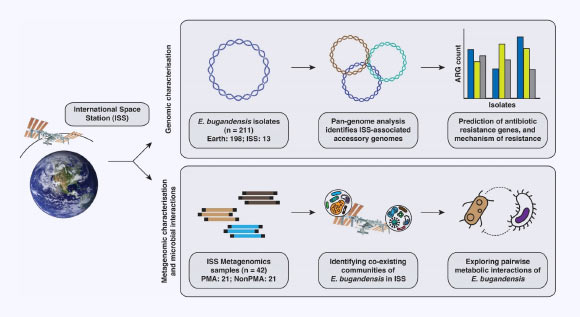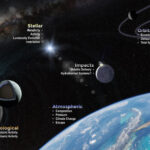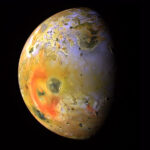Enterobacter bugandensis is primarily found in clinical specimens including the human gastrointestinal tract.
Illustrative workflow showcasing the process of comparative genomics analysis of Enterobacter bugandensis, evaluating its prevalence and metabolic interactions within the microbial community, and its successful adaptation within the ISS habitat. Image credit: Sengupta et al., doi: 10.1186/s40168-024-01777-1.
The International Space Station (ISS) stands as a testament to human achievement in space exploration.
Despite its highly controlled environment, characterised by microgravity, increased carbon dioxide levels, and elevated solar radiation, microorganisms occupy a unique niche.
These microbial inhabitants play a significant role in influencing the health and well-being of astronauts on board.
One microorganism of particular interest is Enterobacter bugandensis, a Gram-negative bacterium notorious for being multi-drug resistant.
“Microorganisms within built environments profoundly affect the health of inhabitants,” said senior author Dr. Kasthuri Venkateswaran from NASA’s Jet Propulsion Laboratory and colleagues.
“The ISS, a highly controlled built environment harboring extreme conditions such as microgravity, solar radiation, and elevated carbon dioxide levels levels, offers a unique place for studying microbial survival and adaptation.”
“Recent studies have demonstrated that microorganisms exposed to microgravity can acquire antibiotic resistance and heightened virulence via rapid mutations and horizontal gene transfer.”
“Prolonged space travel under microgravity can also compromise astronauts’ immune systems, elevating their vulnerability to diseases.”
“The microbial population of the ISS might potentially impact astronauts’ microbiomes and get replenished by the arrival of new crew.”
“Thus, understanding microbial colonization, succession, and interactions is pivotal for ensuring astronaut well-being and managing microbial risks in isolated and confined human habitats.”
In their new study, the authors analyzed thirteen strains of Enterobacter bugandensis isolated from the ISS.
Their results indicate that under stress, these strains were mutated and became genetically and functionally distinct compared to their Earth counterparts.
The strains were able to viably persist on the ISS over time with a significant abundance.
They coexisted with multiple other microorganisms, and in some cases could have helped those organisms survive.
“Our comprehensive analysis illuminated not only the ways these interactions sculpt microbial diversity but also the factors that might contribute to the potential dominance and succession of Enterobacter bugandensis within the ISS environment,” the researchers said.
“The implications of these findings are twofold,” they added.
“Firstly, they shed light on microbial behavior, adaptation, and evolution in extreme, isolated environments.”
“Secondly, they underscore the need for robust preventive measures, ensuring the health and safety of astronauts by mitigating risks associated with potential pathogenic threats.”
The findings appear in the journal Microbiome.
_____
P. Sengupta et al. 2024. Genomic, functional, and metabolic enhancements in multidrug-resistant Enterobacter bugandensis facilitating its persistence and succession in the International Space Station. Microbiome 12, 62; doi: 10.1186/s40168-024-01777-1




